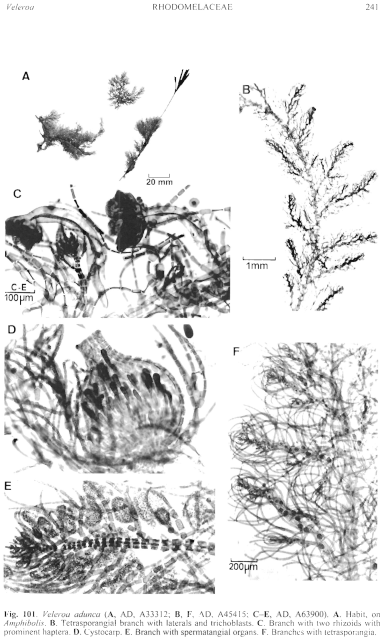|
|
|
|
|
|||||||||||
|
Electronic Flora of South Australia Species Fact Sheet
Phylum Rhodophyta – Family Rhodomelaceae – Tribe Lophothalieae
Synonyms
Dasya adunca J. Agardh 1890: 112. Lucas & Perrin 1947: 315.
Thaumatella disticha (Falkenberg) Kylin 1956: 511. May 1965: 379.
Brongniartella disticha Falkenberg 1901: 550, pl. 24 figs 20–22. De Toni 1903: 1015. Lucas 1909: 43. Lucas & perrin 1947: 285.
Thallus (Fig. 101A, B) dark red-brown, 1–4 cm high, tufted, with prostrate axes bearing slender, moderately to densely branched, erect branches bearing rhodoplastic trichoblasts from each segment on a 1/4 spiral; pericentral cells 4, all branches ecorticate. Attachment by rhizoids (Fig. 101C) from prostrate branches; epiphytic on seagrasses or algae. Structure monopodial, with dome-shaped apical cells and trichoblasts cut off from subapical cells 4–6, with pericentral cells just below this; mature branches 90–140 (–170) µm in diameter, segments L/D 1–1.5. Trichoblasts 0.5–1.5 mm long, branched more or less in an upwardly curved plane, basally branched 1–3 times, 1–2 cells apart, tapering gradually with long, slender, unbranched ends (sometimes lost); basal cells 35–55 µm in diameter and L/D (1–) 1.5–2, mid cells 15–20 µm in diameter and L/D 2–4, and the slender ends 10–12 µm in diameter, cells L/D (1–) 1.5–3. Rhizoids arising from pericentral cells, 1–5 cells long, with multicellular haptera. Lateral branches arising irregularly radially, on basal cell of trichoblasts. Cells uninucleate; rhodoplasts discoid, sometimes chained.
Reproduction: Gametophytes dioecious. Procarps arising on suprabasal cell of trichoblasts, the segment becoming polysiphonous. Carposporophytes with a slight basal fusion cell and branched gonimoblast bearing clavate terminal carposporangia 20–30 µm in diameter. Cystocarps (Fig. 101D) almost sessile, ovoid, 300–500 µm in diameter, with a pronounced, usually flared, neck 80–140 µm long; pericarp ecorticate, with 12–16 erect filaments, each cell cutting off 2 outer isodiametric cells. Spermatangial organs (Fig. 101E) on lower to mid cells of trichoblasts, ovoid, 45–90 µm in diameter and L/D 1–2, with a sterile basal cell only, and 3–6 axial cells bearing lateral initials which divide and produce the outer layer of spermatangia.
Tetrasporangia in lesser branch systems (Fig. 101F) 1–2 mm long, with trichoblasts on each segment, spirally arranged and one per segment, slightly bulging the branch; tetrasporangia 50–80 µm in diameter, with cover cells.
Type from King George Sound, W. Aust; lectotype in Herb. Agardh, LD, 44372. Probable isolectotype in MEL, 1006689.
Selected specimens: Port Turton, Yorke Pen., S. Aust., 8–10 m deep (Kald, 5.ix.1970; AD, A37263). Port Victoria, S. Aust., on Distromium flabellatum, 3–4 m deep (Kraft, 20.ix.1973; AD, A44544). Off Semaphore, S. Aust., on Heterozostera, 15 m deep (Shepherd, 28.xii.1968; AD, A33312). West Beach, S. Aust., on Amphibolis, drift (Parsons, 4.x.1968; AD, A32599) and on Posidonia, 5 m deep (Shepherd, 13.xi.1970; AD, A37691). Port Stanvac, S. Aust., on Ecklonia, 6 m deep (R. Lewis, 14.vi.1972; AD, A42477). Aldinga, S. Aust., on Posidonia, 7 m deep (Johnson, 7.vii.1973; AD, A43884). Emu Bay, Kangaroo I., S. Aust., on Acrocarpia, 10–12 m deep (Lavers, 20.xii.1996; AD, A66899). Saunders Beach, Eastern Cove, Kangaroo I., S. Aust., drift (Womersley, 21.xi.1968; AD, A32895). Penneshaw, Kangaroo I., S. Aust., on Cladurus, 6 m deep (Lavers, 8.i.1997; AD, A66882). Crawfish Rock, Westernport Bay, Vic., on Phycodrys, 6 m deep (Watson, 28.v.1974; AD, A45415). Arch Rock, off Ninepin Point, SE Tas., epiphytic, 1–10 m deep (Andrews, 21.x.1994; AD, A63900). Great Taylor Bay, Bruny I., Tas., 2–5 m deep (Shepherd, 14.ii.1972; AD, A42112).
Distribution: King George Sound, W. Aust., to Westernport Bay, Vic., and SE Tasmania.
Taxonomic notes: Veleroa adunca occurs in sheltered conditions, most commonly as an epiphyte on seagrasses.
References:
AGARDH, J.G. (1890). Till algernes systematik. Acta Univ. lund. 26(3), 1–125, Plates 1–3.
DE TONI, G.B. (1903). Sylloge Algarum omnium hucusque Cognitarum. Vol. 4. Florideae. Sect. 3. pp. 775–1521 + 1523–1525. (Padua.)
FALKENBERG, P. (1901). Die Rhodomelaceen des Golfes von Neapel und der angrenzenden Meeres-abschnitte. Fauna und Flora des Golfes von Neapel. Monogr. 26. (Friedländer: Berlin.)
KYLIN, H. (1956). Die Gattungen der Rhodophyceen. (Gleerups: Lund.)
LUCAS, A.H.S. & PERRIN, F. (1947). The Seaweeds of South Australia. Part 2. The Red Seaweeds. (Govt Printer: Adelaide.)
LUCAS, A.H.S. (1909). Revised list of the Fucoideae and Florideae of Australia. Proc. Linn. Soc. N.S.W. 34, 9–60.
MAY, V. (1965). A census and key to the species of Rhodophyceae (red algae) recorded from Australia. Contr. N.S. W. Natl Herb. 3, 349–429.
The Marine Benthic Flora of Southern Australia Part IIID complete list of references.
Publication:
Womersley, H.B.S. (24 February, 2003)
The Marine Benthic Flora of Southern Australia
Rhodophyta. Part IIID. Ceramiales – Delesseriaceae, Sarcomeniaceae, Rhodomelaceae
Reproduced with permission from The Marine Benthic Flora of Southern Australia Part IIID 2003, by H.B.S. Womersley. Australian Biological Resources Study, Canberra. Copyright Commonwealth of Australia.
Illustration in Womersley Part IIIA, 2003: FIG. 101.

Figure 101 enlarge
Fig. 101. Veleroa adunca (A, AD, A33312; B, F, AD, A45415; C–E, AD, A63900). A. Habit, on Amphibolis. B. Tetrasporangial branch with laterals and trichoblasts. C. Branch with two rhizoids with prominent haptera. D. Cystocarp. E. Branch with spermatangial organs. F. Branches with tetrasporangia.

|
Email Contact: State Herbarium of South Australia |

|